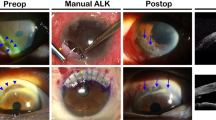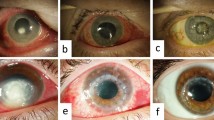Summary
Background: Donor corneas are normally obtained by whole globe enucleation – a procedure often refused by the bereaved. To increase the acceptance of cornea donation, we have exclusively obtained donor corneas by in situ excision since the end of 1994. There have been reports of increased endothelial damage and higher contamination rates. We report our experience in 1995 and 1996.
Methods: The in situ excision was performed by staff trained in microsurgical techniques. Only donor corneas with negative end-storage cultures after at least 10 days and an endothelial cell count of more than 2500 cells/mm2 were used for transplantation.
Results: In all, 705 corneoscleral buttons were excised from 1/95 to 12/96. The bereaved consented in 34 % in 1996. A total of 30.5 % of the corneas were ineligible for transplantation which corresponds to the discard figures from all cornea banks with culture methods. We did not observe any primary transplant failure nor endophthalmitis after 444 perforating keratoplasties.
Conclusion: In situ corneal excision is safe, and helps to reduce the shortage in donor corneas.
Hintergrund: Spenderhornhäute werden meist durch Enukleation gewonnen, was bei Angehörigen oft auf Ablehnung stößt. Um die Akzeptanz der Hornhautspende bei dem herrschenden Transplantatmangel zu erhöhen, entnehmen wir seit Ende 1994 Spenderhornhäute nur noch korneoskleral. Bedenken gegen diese Entnahmetechnik bestehen wegen möglicher Endothelschädigung und mikrobieller Kontamination. Wir berichten über unsere Erfahrungen in den Jahren 1995 und 1996.
Methode: Die korneosklerale Entnahme an der Leiche erfolgte ausschließlich durch mikrochirurgisch geschulte Mitarbeiter. Es wurden nur Korneoskleralscheiben mit mikrobiologisch unauffälligem Organkulturmedium nach mindestens 10 Tagen Kultur und mit einer Endothelzelldichte von über 2500 Zellen/mm2 zur Transplantation verwendet.
Ergebnisse: Von Januar 1995 bis Dezember 1996 haben wir 705 Korneoskleralscheiben entnommen. Die Zustimmungsquote (Einverständnisse der Angehörigen/Anzahl der Gespräche) betrug 1996 34 %. Der Anteil zur Transplantation nicht geeigneter Hornhäute betrug 30,5 % und lag damit im Rahmen aller Hornhautbanken mit Kulturverfahren. Bei 444 perforierenden Keratoplastiken wurde weder ein primäres Transplantatversagen noch eine Endophthalmitis beobachtet.
Schlußfolgerung: Die korneosklerale Transplantatentnahme ist eine sichere Methode, die durch eine hohe Akzeptanz bei Spenderangehörigen den Transplantatengpaß zu beseitigen hilft.
Similar content being viewed by others
Author information
Authors and Affiliations
Rights and permissions
About this article
Cite this article
Hudde, T., Reinhard, T., Möller, M. et al. In situ corneal excision – Experience of the Lions Cornea Bank of Nordrhein-Westfalen in 1995 and 1996. Ophthalmologe 94, 780–784 (1997). https://doi.org/10.1007/s003470050203
Issue Date:
DOI: https://doi.org/10.1007/s003470050203




